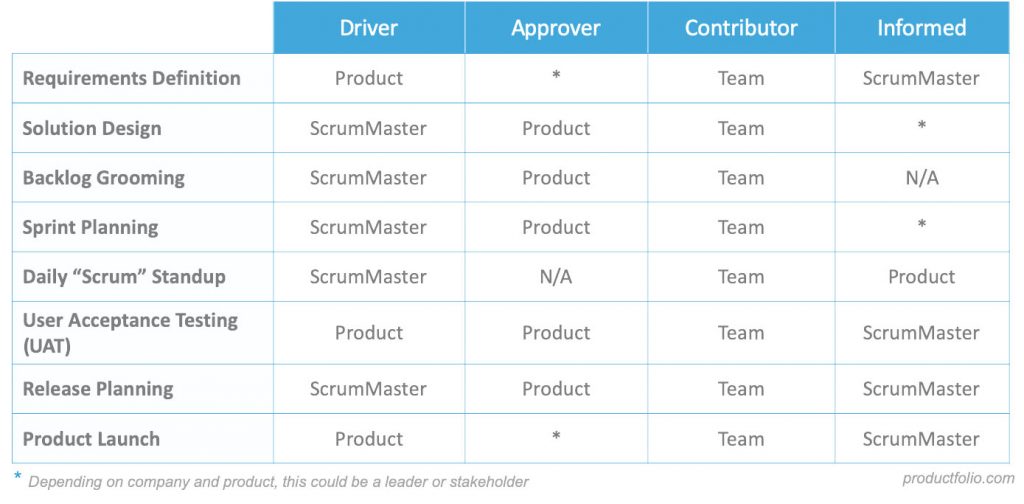What is DACI?
DACI is a responsibility assignment model for determining the roles a team will play, while making decisions or working on a project. It’s an acronym that stands for Driver, Approver, Contributor, Informed. DACI is similar to the better-known RACI model , but ideal for Product development teams, because it emphasizes ownership rather than delivery in the model.
Each letter signifying a role that is assigned to a team member. The challenge DACI seeks to address is dis-ambiguating who does what, to minimize conflict and maximize responsibility and ownership, so the team works with consistency and harmony, toward the end goal.

Work assignments are often left incomplete due to team members assuming the work is someone else’s to complete, or they want to leave the assignment alone, hoping someone else will assume the role while their plate is full. DACI creates clarity among the team as to what the expectations and responsibilities are for each team member.
The DACI Framework
- Driver – Team Manager
- Approver – Decision Maker
- Contributor – The Advisor
- Informed – The Informed Worker
Defining Roles with the DACI Framework
It’s critical to put the right people in the right roles for a DACI to be successful. Think of a car, a child cannot be the driver of a car because they don’t have a license. Similarly, the passenger giving the directions must know where they’re going in order to be the informant to the driver.
The Driver – The driver will be overseeing the entire project from start to finish. The driver does not necessarily do all of the work, but they will manage and lead the team the whole way through, like the CEO of a company.
The Approver – The approver has the authority to make final decisions on the project, they have veto power. There can be more than one approver, general the more approvers the longer it can take so fewer are better when time is of the essence. In Agile Product Management, this should be the Product Manager, or someone within the Product team. In more traditional organizational structures, this might be an executive business sponsor.
The Contributor – The contributor is skilled in their area and may contribute to the body of thought or the development effort that is undertaken, but they are not making the final decision. There are often multiple contributors in a working group.Think of upper-level executives, and department heads as contributors.
The Informed – The informed are those who are directly affected by the decisions made by the Driver, the Approver, and the insights provided by the contributor. The informed have little to no decision-making power and are the ones that act out the tasks. Think of manager-level employees and below.
It’s important to note that in a group DACI there can only be one driver, and ideally one approver. However, the other roles can have multiple people assigned, and each team member can have multiple roles. For example, a contributor can also be informed, so they can be assigned C and I.
Implementing a DACI
Once you have the roles of the DACI agreed on, you’ll want to implement the roles and get going on breaking projects down into tasks. Make sure you have only one Driver that is assigned per task. It can be a different team member per task as long as there is only one person responsible for bringing each task to completion. One the driver is in place per task, you’ll assign ideally one approver per task and the contributors. Once all roles are assigned, the driver gets started on creating an action plan and developing the workflow for their assigned task.
For example, the Product Owner is Driving requirements definition, though the team may contribute insights to Product where it is helpful. There shouldn’t be anyone on the team who needs to Approve the requirements, though it’s possible a Business or Product leader outside of the Scrum team may practice some level of oversight. And, the ScrumMaster would be kept informed of the requirements as they enter the Scrum team, so they can manage the team’s activities against them, accordingly.
Here is an example table that maps the common activities and responsibilities as reference.

When is DACI Beneficial?
A DACI is the most beneficial when you’re working with a cross-functional team and have complex projects that need to be completed quickly and efficiently. It can also be helpful in dis-ambiguating ownership when you have multiple stakeholders with opinions about the outcome of an effort. The DACI framework has been proven as an ideal tool for Product Managers to streamline the workflow of a cross-functional team by adding clarity and ownership to each team member’s role.